|
Tracks Across the Sky
To span the valley, the Kinzua
Viaduct had to be the loftiest
Structure of its kind on earth.
By: W. George Thornton
Erie Railroad Magazine, August 1949
Coal, Timber, Oil! Here were the magic words
of a million endeavors in the adventurous and expanding America of the
1880?s. Moving words too for a man like General Thomas L. Kane who
would build his own railroad to break the mountainous isolation of his
vast and rich 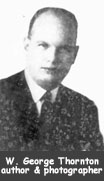 domain
high in the Alleghenies of northern Pennsylvania. domain
high in the Alleghenies of northern Pennsylvania.
Pushing southward from the Erie's terminus at Bradford, Kaneís
New York, Lake Erie and Western Railroad and Coal Company line moved up
the steep and heavily wooded slope of the Big Shanty in the great reverse
curve and thence across a high plateau until the valley of the Kinzua Creek
challenged the abilities and dreams of enterprise and engineer. The
water of many and large fishes as the Indians knew the Kinzua lay at the
bottom of a defile 2,000 feet wide and 300 feet deep. To Kane the
Kinzua gave two alternatives. One was the construction of four miles
of tortuous, twisting two percent grade; the other the erection of a railroad
viaduct loftier than any yet built by men. The General investigated
the latter possibility and found his answer in the person of Anthony Bonzano
o the Clarke Reeves Division of the Phoenixville Bridge Company.
?We'll build you a bridge a thousand feet high Bonzano told Kane, if you'll
provide the money The General had the money, and Bonzano, using propositions,
which had proven their worth in similar structures joined with Oliver W.
Barnes, chief engineer of the railroad, in planning the first Kinzua Viaduct.
Construction began May 10, 1882. Just ninety four working days
later a crew of forty men had completed the highest railroad viaduct in
the world. The astonishing feat involved the erection of 3,105,000
pounds of ironwork into a structure 301 feet high and 2,053 feet long.
The work was done without use of scaffolding. A gin pole was used
to erect the first tower. A wooden crane erected at the top of the
top of the first tower was used to place the ironwork of the second tower.
This procedure was repeated until all twenty towers had been raised and
the connecting latticework spans placed.
Stone secured from the nearby hills provided the footings which rose
as high as sixteen feet above the ground and which went down as far as
thirty five feet below the surface John C. Noakes placed the stone work
which was joined to the iron work by one and one half inch bolts, six to
ten feet in length.
Legs of the supporting towers were flanged, wrought iron columns nine
and three quarters inches in diameter spliced at every panel by inside
sleeves. Strengthened by longitudinal and transverse horizontal latticework
struts, the legs were guardrails stiffened by diagonal tie rods in the
vertical, horizontal and transverse planes of each panel. Additional
supporting columns ascended vertically to the fifth story midway between
the legs of the tallest towers. These columns were connected at each
story by a tubular horizontal strut for further stiffness.
The supporting legs sloped inward transversely in the ratio of one to
six. Towers were uniformly nine feet wide at the top. At the
lowest point the tallest tower had a spread of one hundred and three feet.
Each tower had a span of thirty eight and one half feet. Towers were
joined by sixty foot latticework spans. The entire structure was
bolted together save for the prefabricated latticework girders.
The completed viaduct was a swaying structure. From the beginning
it was necessary to restrict the speed of trains to five miles an hour
as even at this speed vibration while not dangerous was unpleasant.
The entire structure was such that even wind pressures would set the viaduct
in motion.
From the beginning the idea has persisted that the original Kinzua Viaduct
was of wooden construction. This erroneous idea perhaps developed
from the fact that the supporting legs were tubular and thus resembled
wooden poles. Likewise, the ties, walkways and guardrails were of
wood and these features of the structure were the most apparent to those
who examined it but casually. Moreover, the wooden guardrails were
of latticework construction and very similar in proportions to the latticework
iron girders.
Fell Thirty Times
Charles P. Stauffer superintended construction and upon completion of the
viaduct took up his residence within the shadow of the structure, remaining
on as the viaduct inspector. Each week he inspected every bolt and
rod and suffered more than thirty falls in the coarse of his work.
He survived one fall of 210 feet while making a test of a fire escape for
skyscrapers for an inventor. Stauffer succumbed following a sixty
foot fall just before the turn of the century and was succeeded by Walter
S. Meserve who was an inspector until the erection of the second Kinzua
Viaduct or Bridge as it is often called.
Two years after Stauffer became the bridge inspector he became the father
of a son to whom the name Andrew Kinzua was given. ?Andy? Stauffer,
faced with the problem of supporting a family of six following his father's
demise went to work as a water boy when the original viaduct was replaced
with a stronger structure in 1900. Subsequently, ?Andy? served the
Erie for forty eight years during which time he rose from water boy to
painter; from painter to bridge inspector. In 1926 he became general
bridge inspector for the railroad, a position that he held until his retirement
in 1948. Today he lives in Jamestown, N.Y.
The original Kinzua Viaduct was advertisement as the Eighth Wonder of
the World. People from all over civilized world were attracted to
the site. Dollar excursions were run on Sundays from the cities as
far distance as Buffalo and Pittsburgh. It was not unusual for six
or eight excursion trains of ten to fourteen cars to cross the bridge on
a summer Sunday. Crossing the Kinzua Viaduct by train was considered
a great thrill. However, Kinzua excursions were memorable in other
ways. It is said that train butcher would frequently empty drinking
water containers prior to start of an excursions, then sell salted peanuts
on their first trips through the cars. With everyone thirsty they
would do a land office business in lemonade, which had concocted in a barrel
in the baggage car of water, citric acid and half dozen lemons. The
gullible were targets for sharpers and gamblers who, despite the efforts
of railroad detectives, managed to operate the old army and shell games
to the loss and sorrow of those who had grown tired of examining the viaduct.
Occasionally, there was drunkenness and fighting and rare indeed was the
excursion train that failed to have its tender utilized as a beer cooler.
The Bridge House, a hostelry and the dance pavilion situated at the end
of the viaduct operated by a man named Lewis did a land office business
at exorbitant prices.
Adventurous excursionists would often try their skill at climbing the
structure. Usually, they were hailed down by the bridge tender before
they found themselves in trouble or had to be helped down from the ironwork.
However, the bridge inspector would often thrill the excursionists by climbing
the viaduct with his son on his back.
Some idea of the popularity of the Kinzua excursions was more than sufficient
to offset the $167,000 cost of the original structure. The last excursion
took place shortly before America's entry into First World War.
Replacement of the original viaduct was necessitated not by any defect
in the structure but rather by an unexpected and sudden increase in the
weight of locomotives and rolling stock. After only 18 years of service
it was necessary to replace the first Kinzua Viaduct with a newer and stronger
structure.
The second and present Kinzua Viaduct is of identical overall dimensions
with the first bridge. It is, however, designed to accommodate double
headed, ?consolidation? locomotive with loads of 35,000 pounds per axle.
Traffic over the original bridge was halted May 14, 1900 and resumed
over the new structure September 25. Reconstruction did not begin
until May 24 and the last girder was placed September 6. The work
was accomplished in four months by between 100 and 150 men working 10 hours
a day. This despite a week long strike; the speech of a presidential
candidate whose private car was brought to the site over the Kushequa Railroad
which had been built in the 1890?s to run beneath the viaduct; and a forest
fire which originating beneath the viaduct, swept unchecked through the
timber slashings to consume two communities before being brought under
control at the edge of a third town.
The reconstruction, directed by CAW. Buchholz chief engineer of the
Erie and executed by the Elmira Bridge Company, involved the removal of
3,105,000 pounds of mild steel in the new viaduct. The work proceeded
from both ends where storage yards were located. It was affected
by the use of two 180 foot timber travelers, each a complete Howe truss,
16 foot deep. These spanned three towers. The middle tower
was demolished and reconstructed. Then the traveler was moved to
effect the reconstruction of the next tower. The work moved at the
astonishing rate of 500 feet a month. The highest tower and its adjoining
spans were demolished in one day. Rebuilding of the same tower and
the adjoining spans required seven and one half days. The water boy,
Andy Kinzua Stauffer, enjoyed the privilege of removing the first bolt
from the old structure and of driving the final golden rivet in the new
viaduct. Thirty seven miles of rivet rod were used in assembly.
Supporting posts of the new structure were of plate and lattice construction
and measured 24 by 30 inches. The latticework spans of the old structure
were replaced by girders five and one half feet deep at the tower tops
and six and one half feet deep in the spans between the towers.
Engineer Chanute
Octave Chanute, for whom the U.S. Army Air Field in Illinois was to be
named, served in an engineering capacity on both structures. It was
he who worked out the problem of wind stress on the second structure designing
it to withstand a pressure of fifty pounds per square foot when unloaded
and thirty pounds to the square foot when loaded. The smaller figure
for the loaded bridge is due to the fact that pressure of thirty pounds
to the square foot would be sufficient to blow a train from the structure.
Wind is a very real factor in the Kinzua valley and within a year after
the second viaduct was erected it was blown two and seven eighths inches
out of line. At times the wind has been strong enough to relieve
staked gondolas of their tanbark loads and to unroof boxcars. Trainmen
will tell of being unable to stand upright on the deck of the viaduct in
a high wind and even on apparently calm days painters have found it difficult
to work.
Since its erection the viaduct has been painted on an average of once
in every seven years. The original stone piers were encased in concrete
between 1907 and 1933. These with the abutments bear the chiseled
initials of generations of visitors.
The present Kinzua Viaduct, like the original, still serves as a tourist
Mecca. Thousands still visit the Kinzua every year and hundreds will
be attracted to it on a sunny, summer, Sunday afternoon. Its plate
and lattice legs have challenged climbers of both sexes. Some have
succeeded in reaching the top; others have become faint hearted, ?frozen?
to the structure and have had to be assisted down. However, the outstanding
feat of balance recorded is that of the two young men who in 1901 mounted
the cap strips of the guard railings and keeping abreast crossed the viaduct
on a four inch plank 305 feet above the Kinzua Creek. There are,
too, records of two other individuals who have accomplished this feat?
of nerve and balance.
The lore of the viaduct is studded with legend. Most appealing
of all the stories is that which has to do with buried treasure.
Within sight of the Viaduct lies $40,000 in gold and currency buried in
glass containers by a bank robber near the turn of the century. To
date the loot has not been recovered.
The Kinzua has been surpassed in height by other viaducts. It
is eclipsed by the 336 1/2 foot Loa Viaduct in Chile, by the 335 foot Gokteik
in Burma and by the 362 foot Pecos River Viaduct in Texas. However,
the Kinzua is believed today to be the second highest viaduct on the North
American continent and it is doubtful if any viaduct in the world of its
type exceeds it in both length and height.
Today the Kinzua remains one of the great viaducts of the modern world.
Despite rumors and fantastic flights of fancy to the contrary, it has not
collapsed nor has it been destroyed for the benefit of the motion picture
cameras in a super colossal head-on collision of trains assisted by a few
sticks of dynamite to make a Roman holiday for Hollywood.
Bulletin
After the preceding pages of the story, ?Tracks Across the Sky,? had been
made up, the author came upon some sidelights and sent them on to us.
He says: ?J. Belmont Mosser of St. Mary's, Pa., who has just retired
as president of Kiwanis International, sold peanuts and popcorn on early
Kinzua excursions.?
Quoting Attorney Thomas J. Hurley of Gary, Ind., he writes:
?There may have been others walked the length of the viaduct
atop the handrail, but, believe it or not, two of the youthful and perhaps
foolhardy adventurers who did it were yours truly and an old friend, Jack
Flaherty. This was a day or two after the work was completed.
We discussed doing the stunt at the same time with a piece of rope between
us, he on one side and I on the other, to insure against one falling; yet
we abandoned this as too sissified. But we were accustomed to working
great heights and were young, strong and of steady nerve.?
About the Author
?I'm on the Era roster as an extra engine pumper and put in shift more
and then taking care of a couple 3100s at Clarion Junction which includes
coaling, sanding, cleaning fires and shoveling cinders in weather fair
and foul. I've spent a goodly portion of my life along the Erie living
at Jamestown. I was graduated from high schools and Meadville where
I could see the Erie yards and shops from my fraternity house windows.
I've received an education at Dunkirk, N.Y. Business Institute, Allegheny
College, Boston University Graduate and Theological Schools and done special
work at Yale and Emerson College of Oratory. I've served two pastorates
of the Methodist Church, Waterford and Johnsonburg, Pa. Have an avid
interest in photography, writing, stamp collecting and have 200 hours as
a pilot.?
Gordon Ruoff Collection
|
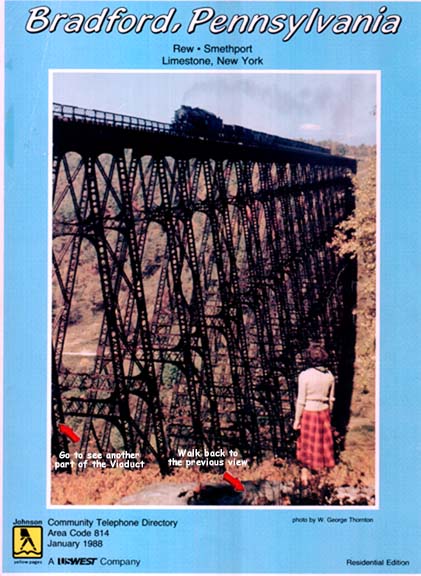

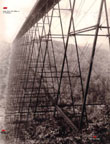 1883
Kinzua Bridge
1883
Kinzua Bridge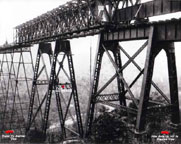 1900's
Kinzua Reconstruction
1900's
Kinzua Reconstruction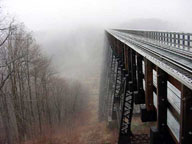 2000
Kinzua Bridge
2000
Kinzua Bridge